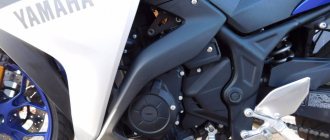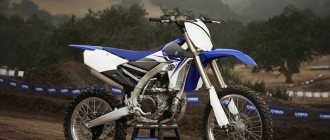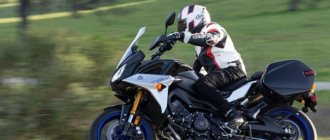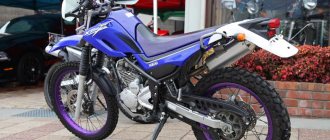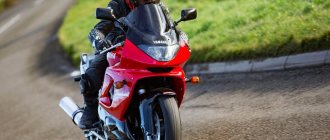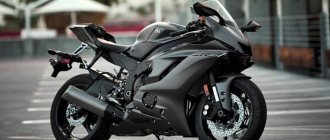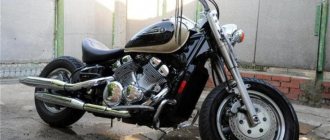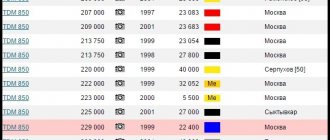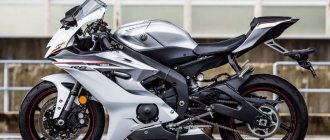| Yamaha YZF-R3 (2015-2018) | Yamaha YZF-R3 (2019+) | Yamaha YZF-R3 World GP 60th Anniversary Edition (2022) |
Yamaha R3 (YZF-R3) Beginner Sports Motorcycle Model
was introduced in 2015. The appearance of this model was due to Yamaha’s desire to take a leading position in the market of small-capacity motorcycles for beginners and to compete, first of all, with the Kawasaki Ninja 300 model. Similar models from other Japanese manufacturers, and in particular the Honda CBR 250 and Honda CBR 300, although and are in the same class, but are objectively less interesting motorcycles due to a simple 1-cylinder engine.
Looking at the Yamaha R3 model, it immediately becomes clear that this model is the answer to the Kawasaki Ninja 300 - it has the same 2-cylinder injection engine, but it has a slightly larger volume (321 cc versus 296 cc) and produces high power and torque characteristics - 42 hp. at 10,750 rpm and 29.6 Nm at 9,000 rpm. In addition, Yamaha relied on the similarity of the motorcycle with the top models of the R-series and the alleged belonging of the Yamaha YZF-R3 to this series. Although, naturally, the model has nothing in common with them, and these statements are only a well-thought-out marketing ploy.
Key features of the Yamaha YZF-R3 include a steel diagonal frame, fuel injection, ABS (versions without ABS are available on the North American market), simple suspension in the form of a conventional telescopic fork and rear monoshock, as well as a 6-speed gearbox. Curb weight - 169 kg.
The Yamaha MT-03 naked model, which has been on sale since 2021, was also built on the Yamaha R3 platform.
In 2021, the R3 model is restyled, receiving an updated appearance, LED optics, an LCD instrument panel and an inverted fork.
Based on the R3, a 250 cc version of the Yamaha YZF-R25 is also offered, aimed at some local markets (Japan, Southeast Asian countries, Turkey).
The main competitors of the Yamaha R3 in the class:
- Kawasaki Ninja 300
- Honda CBR 300/Honda CBR400R
Brief history of the model
- 2015 - start of production and sales of Yamaha YZF-R3. First generation.
Model
: Yamaha YZF-R3 + ABS (all regions).
Factory designation
: 2MS1 (USA), 2MS2 (Canada); B021 (Japan), B023, B024 (Europe).
- 2016 - no significant changes.
Model
: Yamaha YZF-R3 + ABS (all regions).
Factory designation
: 2MS3 (USA), 2MS4 (Canada); B021 (Japan), B02B, B02C (Europe).
- 2017 - no significant changes.
Model
: Yamaha YZF-R3 + ABS (all regions).
Factory designation
: 2MS6 (Canada); B02J (Japan), BY92 (Canada).
- 2018 - no significant changes.
Model
: Yamaha YZF-R3 + ABS (all regions).
Factory designation
: B02N (Japan), BR52 (Europe).
- 2019 - restyling of the model. Second generation
.
Model
: Yamaha YZF-R3 + ABS (all regions).
- 2020 - no significant changes.
Model
: Yamaha YZF-R3 + ABS (all regions).
- 2021 - no significant changes.
Model
: Yamaha YZF-R3 + ABS (all regions).
- 2022 - the appearance of the anniversary version of the Yamaha YZF-R3 World GP 60th Anniversary Edition in Yamaha's signature racing colors.
Model
: Yamaha YZF-R3 + ABS; Yamaha YZF-R3 World GP 60th Anniversary Edition (all regions).
For whom is it intended?
The main users of this motorcycle are beginners with aesthetic needs.
Based on the statement of company representatives that the bike is planned for sales on all continents and in all countries, we can conclude that it was intended for a person of average and tall height .
However, the position of the mirrors and the saddle for the driver clearly indicate that it is better for a tall biker to look for another model.
Modifications
According to the designers, the model was supposed to be better than the development from Kawasaki. The goal has been achieved, no modifications are planned .
However, in 2021, the concern launched the Yamaha MT-0 3, a naked bike for beginners. It is based on the YZF R3.
Specifications
Yamaha R3 (YZF-R3) Specifications:
| Model | Yamaha R3 (YZF-R3) |
| Motorcycle type | sport |
| Year of issue | 2015+ |
| Frame | steel |
| engine's type | 2-cylinder, 4-stroke, in-line |
| Working volume | 321 cm³ |
| Bore/Stroke | 68.0 x 44.1 mm |
| Compression ratio | 11,2:1 |
| Cooling | liquid |
| Number of valves per cylinder | DOHC, 4 valves per cylinder |
| Fuel supply system | injector |
| Ignition type | TCI |
| Maximum power | 42.0 hp (31.0 kW) at 10750 rpm |
| Maximum torque | 29.6 Nm (3.0 kg*m) at 9000 rpm |
| Clutch | Multi-disc in oil bath, cable drive |
| Transmission | 6-speed |
| type of drive | chain |
| Front tire size | 110/70-17M/C (54H) |
| Rear tire size | 140/70-17M/C (66H) |
| Front brakes | 1 disc, 298 mm, 2-piston caliper (ABS) |
| Rear brakes | 1 disc, 220 mm, 1-piston caliper (ABS) |
| Front suspension | 41 mm telescopic fork (non-adjustable), 130 mm travel 37 mm inverted fork, 130 mm travel - from 2021 |
| Rear suspension | pendulum with monoshock absorber (preload adjustment), stroke - 125 mm |
| Length | 2090 mm |
| Width | 720 mm 730 mm - from 2021 |
| Height | 1135 mm 1140 mm - from 2021 |
| Wheelbase | 1380 mm |
| Minimum ground clearance (clearance) | 160 mm |
| Seat height | 780 mm |
| Acceleration 0-100 km/h (0-60 mph) | 6.52 sec[1] |
| Maximum speed | 184 km/h[2] |
| Gas tank capacity | 14.0 l (including reserve - 3.0 l) |
| Motorcycle weight (curb) | 169 kg 170 kg - from 2021 |
Driving performance
The maximum speed indicated in the documents is 175 km/h . Users who managed to “touch” the new model claim that this is an advertisement.
175 km/h from a hill and with a tailwind. In other conditions the motor will not pull.
Acceleration to hundreds
Acceleration from zero to 100 km/h is also not impressive - 6.5 seconds .
Fuel consumption
If you do not keep the tachometer needle in the red zone, it seems as if the motorcycle is not consuming fuel at all.
Fuel consumption with an average cruiser and a good flat road is 3.8 liters . Mixed - up to 5 l . The specific one depends on the conditions of use.
Motorcycle Yamaha YZF-R 3 2015 review
The description of the Yamaha YZF-R 3 2015 motorcycle is in the queue for publication of the article. Announcement: Today, for almost every new motorcycle that comes into being, marketers strive to carve out their own niche. This one is a road sport, this one is a recreational enduro. But what class should we include a motorcycle that has a little bit of everything? A good bike should have a reliable engine, comfortable ergonomics and simple controls...
The Yamaha YZF-R 3 is a motorcycle of common popularity in Russia, equipped with a high-power 41.4 hp engine. Despite the fact that good models of motorcycles have a very respectable price, and the season for their use is relatively short, the motorcycle market is developing rapidly. And if you believe the words of dealers, then some models of recently released motorcycles are selling like hot cakes at the beginning of the season, and the models brought to Russia are clearly not enough to fully satisfy consumer demand.
A motorcycle has long ceased to be an alternative to a car, and the times when this equipment was bought only because there was not enough money for a full-fledged car are forgotten. Nowadays, two-wheelers can be called technological marvels in many cases, and their cost can be compared with that of prestigious cars.
Many people have started buying motorcycles for hobby purposes as riding or even collecting them has become a good pastime for many people. Many motorcycles, for example the Yamaha YZF-R 3, whose technical characteristics make it possible to call the model a prestigious brand, are in demand among both beginners and experienced motorcyclists.
Motorcycles with an engine capacity of 321 cc / 19.5 cu-in. see, appeared as a result of long work of inventors who sought to create a model that was not inferior in characteristics to other versions of the motorcycle. In some cases, these models are not only not inferior, but also ahead of other motorcycles, as they have minimal fuel consumption and other excellent parameters.
Motorcycles from 250 to 400 kb. see which includes the Yamaha YZF-R 3 - this is the most common class of motorcycles. In this range you already have a choice among almost all classes of motorcycles. Many people call this category the most suitable for a first motorcycle. You can purchase a moderately heavy, powerful and flexible motorcycle for relatively little money. Many people advise taking a road bike with a 400 cc engine as your first choice. We cannot completely agree with this, because such motorcycles often weigh about 200 kg and have a sufficient power reserve. If your skills in riding a two-wheeled vehicle are limited to a training motorcycle at a motorcycle school, then you should not immediately take such a device. Many beginners get into ridiculous accidents simply because they do not know all the features of operating such equipment. After all, the heavier and more powerful the motorcycle, the better you should know how to handle it in different situations. Even a monkey can just drive in a straight line (no joke).
Go to the entire range of Yamaha motorcycles, on this page you can find Yamaha YZF-R 3 motorcycles from other years of production and information about them
Flaws
- Dynamics.
- Price.
- Normal traction is only in the red zone.
and dignity
This is perhaps one of the best lightweight sports bikes for daily use.
- Low center of gravity.
- The ability to sit not only in a sporty way.
- Maneuverability.
- Compactness.
- Convenient, clear instrument panel.
Good day, gentlemen and ladies. I want to tell you the story of buying my first Yamaha R3 bike, my experience in using it, and also give some non-obvious tips for beginners. It will turn out to be a long read, with a lot of water, personal experiences and revelations, but isn’t that what motorcycles are about?
I’ll immediately give a few numbers and statements, in particular for those who are impatient:
- My height is 175
- Weight - 65
- Motorcycle 2021, but pre-style
- Bought new from a dealer in May
- Warranty 3 years unlimited mileage
- Mileage 15000 km
- Maximum speed - 192 mph
- Willie only does it with the clutch
- Up to hundreds in about 5-6 seconds
- Consumption, depending on mode 3.5-8 liters
- Tuning: crash pads
My experience
Since childhood I wanted a bike, of course a sport. I always had my eye on the R6 and CBR 600 - very beautiful bikes, the design of the liters didn’t suit me at all. The first bike appeared in the sunny country of Southeast Asia - a Chinese replica of the Honda Win 125cc. I skated, however, only for a couple of months. In fact, I haven’t gained any experience - everyone drives there like crazy. Nevertheless, I became even more excited about this whole thing. He returned to the CIS, enrolled in a motorcycle school, completed his studies, and passed his license.
Insight for beginners: be sure to go to a motorcycle school. There they teach you how to brake correctly, how to look, they teach counter-steering, they teach you how to balance, and they tell you a bunch of interesting and useful things.
Why it’s important: looking at how my dad rode the R3, I became scared for the bike, of course he has experience in Java and Izha, but damn it, this is completely different. People really think that the main brake is the rear one, and they are sincerely surprised that the bike doesn’t brake or turn at all - the clip-ons are rumored to be, they don’t turn at all. And they ride like bikes. Motorcycle school is a must have.
Purchase background
I buzzed the bike into the ears of everyone I knew. Of course everyone is against it. I didn’t notice how I spend all my free time looking at reviews of small-capacity cars and R6s, leafing through advertisements for sale, etc.. I think everyone has had this.
Babos wasn’t there much, I was looking at a used Kawasaki Ninja 250. And, of course, I was looking at advertisements for the R6. On the one hand, I wanted to buy a “dream”, but something inside me told me that there was no need to rush. And I didn’t want to take the 2009-2010 bike - carburetors, it’s not clear how they were raped (but 100% of them were raped), and the restyling looks much cooler.
And then, after the dubious 600s and small 250s, I discovered a new class of 300s. I saw the 300th Cava, but then I discovered that there are RC390, R3 and CBR300. I started monitoring the price tags - but there were no old ones, all 2016+, but I decided that I could handle it.
I looked through a bunch of reviews, and realized that Kava 250 is no longer needed - it will become boring after the first season. Kava 300 - the design is not mine at all, the Honda looks like a moped and the choice is between the RC390 and R3. Although the Yamaha is assembled in Indonesia, the RC390 is assembled in India - I don’t like Indians at all. It took me a long time to learn about the advantages of one or two cylinders, about the advantages of RC, but I realized for myself that Honda, Yamaha and Kawasaki make good sports. And by that time I had already bought myself hifi speakers from Yamaha, and the brand had penetrated my soul - there are three tuning forks on the logo, and I’m a feeble player, but I play all sorts of instruments.
Once I was drinking with a friend, and I once again enthusiastically told him about my dream and that I didn’t have enough money to start the season, and my regret that I would only be able to buy a new one at the end of the season. A friend expressed his concerns about the bike and especially the sport, and while drunk they decided that if they were to take it, it would be the MT-03 - it doesn’t look like a sport =) I wake up in the morning, my friend says - let’s go to Dolgan, let’s go to the dealer. No, well, it’s awkward, of course, but let’s go.
Purchase
We called the dealer - they have the MT-03 - they have it. Great, let's go.
I arrive, the interior is glass, the entire MT line is there, and out of the corner of my eye I see the R3. Blue =)
2 hours I toiled between MT-03 and R3. I sat alternately on both. What can I say about the seating position - MT, its steering wheel is like a steering wheel. This makes your back straight and you sit upright. The R3 has clip-ons, you lean forward slightly, and it seemed like the saddle was a little higher. I was tossing between the two, but I realized that R3 is dearer. I’m a little interested in MTV, where my bike has a similar seating position - tilted forward. Yes, and the MT was in gray - so-so, but the black one had to wait a month. And then the consultant, the person who bought the R6 as the first bike and miraculously survived after two accidents, told me one very correct thing:
Insight: Take what your heart desires. Why it’s important: And then it dawned on me. Yes, other motorcycles can be more powerful, they can be more reliable, they can be better, 1 second faster. With the rational part of your brain you will convince yourself that you bought something that has some logical basis, but emotionally something will be missing. You need to buy a bike with emotions. After all, we don’t take it for anything else, right?
Equipment
Equipment is expensive, but you can’t skimp on it. Lancarra in one of his videos said something like this: “We did a study and determined that the asphalt in July is as hard as in December.”
My starting set was as follows:
- Shoei helmet - you can’t go anywhere without a helmet. I won’t even say that it’s a must-have.
- Alpinestars motorcycle boots, high - despite a lot of accidents (and who doesn’t), I saw a certain pattern that many impacts fall on the side. And in the legs there are a lot of small and fragile bones, and it is very difficult to collect them in a heap, even with a slight blow.
- Alpinestars gloves - when we fly head first, we instinctively put our hands forward. Riding a bicycle taught me this with 7 broken fingers and skinned palms.
- Alpinestars leather jacket - at that moment, when your bike is on the side, and you are peacefully sliding on your back along the asphalt, it is better to relax and think about high things, rather than howl from the pain of your skin rubbing off on the asphalt. A friend of mine jumped out of a car at 60 km/h - he had a skin transplant on his entire back.
- Arai helmet for number two
Insights
- Equipment is expensive, but necessary. Bikers are divided into those who have already fallen and those who have not yet.
- Bots, well, just a must have. Problems with legs, if something happens, are not always solved. There is a video somewhere by Gav about how a guy was collecting money to amputate his leg, after 3 operations on it. There really are a lot of bones and they are very fragile and very difficult to put back together.
- Jacket or turtle - it's up to you. But remember that turtles are extremely rare in the city. Most of the turtles that hang in motorcycle showrooms are designed for enduro. There are other turtles for the city - there are special anti-scrolling protections that are designed for the city. Please check this point when purchasing.
- The helmet is only integral. About 30% of all helmet impacts occur in the jaw area.
- If you ride someone as number two (and you will), either buy him/her a helmet. Or give your helmet to number two. Driving 70 without a helmet becomes unbearable - tears flow and all sorts of crap flies into your eyes (you will not be tempted to accelerate faster). And the second number will be safer. Remember, you are responsible for number two, his life is in your hands, don’t forget this.
Review of Yamaha R3
Frisky, nimble, forgives mistakes.
Great bike for the city. At traffic lights you are faster than 95% of cars. It’s a pleasure in traffic jams; it’s nimble, light, and controllable.
Overall, this is my first bike and I don't have much to compare it to. However, he is very malleable. Easy to control, enough power to push when needed, but not enough to make mistakes unforgiving.
During this season I skated 15,000, and I understand that this will also be enough for the second season. I don't get bored with it. You can push it, the bike is very playful. The same Kawasaki Ninja 250 remains in the rearview mirror. Up to 60 mph you do 600s from the 90s, then they catch up.
In general, both the lows and highs are good; no obvious drops in power are felt. Nevertheless, I like to ride in the range from 7000. There are no complaints about the engine, and I think it’s not for nothing that Yamaha gives a 3-year warranty without mileage limitation.
A little bit faster:
- He will shave a hundred square meters very quickly.
- 101 mph is third gear at 11,000 rpm
- 140 - also, absolutely no problems, very playful and cheerful.
- 155 is dialed quite well too. This is already the fifth gear after 11500
- 164 is more difficult to type, but confident.
- 172 mph is about 11,200 on the tachometer. It’s getting quite slow. In general, in order to gain speed above 160 you need to hide under the glass.
- 180 is already difficult. Here you need to lie on the forecastle and the weather is good
- 192 is my maximum speed, on the highway, in good, warm, windless weather. At the same time, I caught up to this speed for about 3 minutes. At the same time, the tachometer speed was already almost in the red zone.
Consumption depends very much on driving style. If you keep the revs in the 5000 range, then about 3 liters. But somehow I was driving along the highway at a speed of 168 to 174 - the tank was full. After 160 km, the last division began to flicker - about 2 liters remained. Let me remind you that the tank is 14 liters.
The sound of the bike is interesting, but I don't have enough volume in traffic jams. Few people hear you. Somehow I caught up with the CBRR R600 and Hayabusa with forward flows - in front of them the cars moved to the sides more cheerfully than in front of the ambulance. But they are not afraid of me alone and often do not hear me.
The seating position is comfortable, with a very subtle hint of sport, but not sport. I often travel 150-300 km a day - it feels quite comfortable. The maximum I gave in a day was 640 - it’s difficult, you can feel the trembling in your hands, and your legs are numb.
The cats have taken a fancy to the gray dog. If you leave it somewhere in the parking lot, you come and there are paws there. But my relatives’ cat got under the cover and left a couple of scratches on the seat during the rain.
Insights for beginners: I’m an adherent of 300 now, 250 will quickly get boring, but 300 can be a bit more challenging and playful. You won’t get tired in one season.
On this note, I will conclude the first part of the article, expect the second part in the near future, it will contain:
- R3 operating experience
- Bike maintenance
- My breakdowns
- Comparison of R3 and R6
Competitors (Comparison)
Kawasaki Ninja 300.
Honda CBR300R.
As the developers themselves admit, they had one main competitor - Kawasaki Ninja 300 . Considering that the model is no longer produced, this can be considered a recognition that Yamaha is still better.
But to complete the picture, here are a few numbers.
| Yamaha YZF R3 | Kawasaki Ninja 300 | Honda CBR300R |
| 2-cylinder | 2-cylinder | 1 cylinder |
| injector | injector (our own development) | injector (our own development) |
| 321 cm³ | 296 cm³ | 286 cm³ |
| 42 hp | 38 hp | 31 hp |
| ABS (optional) | ABS (optional) | combi-break. |
As expected, the YZF R3 was superior in every way compared to the Kawasaki.
Honda's low performance largely depended on the fact that for a long time it assembled small-capacity cars on 1 cylinder , putting speed at the expense of safety and ease of maintenance.
Chassis and brakes
The disc brakes here are sufficient: the disc diameter is 220 mm at the rear and 298 mm at the front. The front telescopic fork has 130mm of travel, while the monoshock swingarm has 5mm less travel. In general, the exterior looks quite elegant, but does not shine with special luxury or individuality.
Characteristics of YAMAHA A3R electric-acoustic guitar
The design is comfortable, elegant and expensive, meeting the requirements of refined taste, fashion, and luxury.
We never compromise and the A-series is no exception. Every detail that makes up this guitar is designed to be part of the guitar of your dreams: real wood binding, vintage style inlays, new headstock design and top fingerboards. Perhaps the best way to describe the A-Series design is: elegant, simple but effective. Scratch Guard This pick guard was originally installed on N1000 guitars released in 1975. Thus, the pickguard used in the A-Series guitars is a tribute to the classic design of Yamaha guitars.
Feelings Comfort is a state of physical peace or tranquility, favorable external and internal conditions. Perfectly polished wood. The neck feels in your hand as if you have been playing this guitar for many years. Walk your fingers along the strings and you will experience the “right” sensations. The development of the A Series guitars involved extensive research in close collaboration with musicians, technicians and guitar makers. As a result, the A Series has the superior playability required by today's guitarists. First of all, it is adaptable to various conditions of use - this guitar is excellent both as an acoustic instrument and connected to amplification equipment| convenient for performing on stage, recording, and also for practicing at home.
Special Neck Finish Yamaha's exclusive porous finish retains the feel of natural wood while providing a smooth, durable fretboard finish. Neck Profile: Each A-Series guitar neck is handcrafted, finished and inspected by our experienced and skilled craftsmen - people who know good guitars and place great emphasis on creating the right feel.
Sound Dynamic sound - full of energy, active, exhibiting a wide range of characteristics. The A-Series has been designed with superior sound in mind. Deep, rich lows, an open, extended midrange, and clear, harmonious highs give your music room to breathe and bring out the individuality of your playing. Yamaha's patented ultra-thin finish, carefully hand-selected acoustic woods, combined with premium construction crafted by our finest craftsmen, combine to create a guitar that is unique in tone and character. The A-Series guitar isn't just full of sound - it's full of life.
Stiffeners The special design of solid, no-cut, X-shaped stiffeners provides rich, balanced low-frequency resonance and powerful attack.
top provides natural surround sound and excellent sound projection.
Back Ideal for a wide, smooth frequency response with deep lows and punchy highs.
*Models AC1R, A3R, AC3R, A1R
Mahogany Back and Sides Mahogany has a warm, rich tone with a smooth mid and low end.
* Models AC1M, A1M, AC3M, A3M
Electronics Incorporating advanced Digital Signal Processing technology and delving into the very fundamentals of sound creation and recording techniques, Yamaha creates SRT, a system of piezoelectric pickups and preamps that can deliver amazingly natural-sounding acoustic guitar performance. High-level sound, which previously could only be achieved with the help of a professional sound engineer, expensive equipment and in a studio room, is now available to any guitarist, both when playing on stage and in the studio. Yamaha's new SRT system delivers studio-quality acoustic sound. By using signals from multiple sensors, it is possible to simulate the type of studio microphone and its position relative to the guitar. As the basis for these processes, the SRT system uses the natural acoustic tone of your guitar, resulting in phenomenally realistic and full sound.
SRT Piezo Pickup The patented SRT piezo pickup design uses independent sensing elements for each string, resulting in clean, transparent sound and a wide frequency range. The SRT system's dynamic performance and fidelity are far superior to those of a conventional piezoelectric ribbon pickup.
Yamaha YZF R3 test
Enough about the hardware. Let's go for a ride.
Our small column started in the city. Driving from traffic light to traffic light does not present any problems, due to the short first gear, which will appeal to beginners. The seat height is 78 cm, some may find it high, but the old model had lowering kits, the same can be expected on the 2019 model
The Yamaha YZF R3's pilot position is closer to sports. Controls are easily accessible. The updated display is high-contrast and legible – the selected gear and speed are visible at a glance. The tachometer, located at the top edge of the display, is sometimes difficult to read, but you don’t have to look at it, the engine itself will tell you what it wants.
And here we are on a country road. On the Yamaha R3, I calmly wedged myself into the general flow and it didn’t bother me; this was facilitated, among other things, by the mirrors with good visibility and slight dimming. Yamaha expected R3 owners to drive it to work, but many would prefer the highway. Although someone may have work a hundred kilometers away, this is not a problem for the R3.
At first it seemed that a sporty landing, lying on the tank, would not be very fun, but it turned out that this was not the case; on the contrary, such a landing hides you more under the glass.
At one of the corners I finally figured out a quirk of the bike that had been bothering me for most of the ride. I shifted from fourth to fifth gear and stepped on the gas, but the bike didn't accelerate much, I was expecting more traction. Then I remembered one detail from the presentation: the R3 has two overdrive gears! What a missed marketing opportunity. We could call them “overdrive” and “hyperdrive”. In any case, the motorcycle's maximum speed is achieved in fourth gear, with fifth and sixth being needed to maintain high speeds at lower revs. That's why they are called "overdrives". Novice pilots may not even know that their motorcycle has such gears, and usually there is only one. "Overdrives" are practical and make long trips less tiring and save you from noise at high speeds. Once I figured that out, second, third and fourth gears became my best friends when traveling in the R3. And Yamaha says they use these gears on their Star Venture and Star Eluder touring bikes.
Yamaha YZF-R3 2019
Now let’s refuel and head to the mountains.
Dust, fog and cold forced us to stop at a cafe and while we were waiting for our order, the guys from Yamaha showed us an unofficial function hidden in the motorcycle: glove warmers! The vents in the fairings are perfect for storing gloves and keeping them warm from the engine while you dine.
I appreciated the new suspension around town and on the highway, but it was on twisty, tight sections that it really came into its own. A small sports motorcycle simply has to handle well, and on the Yamaha YZF R3 you will love the grip on serpentine roads. It doesn't wobble in corners or bite under braking, unlike the 250s of yore, which seemed to have ballpoint pen springs in the suspension. But the rear suspension seemed a little soft, but a couple of clicks of spring preload will solve this problem. For reference, I weigh 80 kg.
The bike accelerates smoothly and the power delivery is very linear. The brakes are not super grippy, but respond to the slightest finger movement. If you like to spend long periods of time on race tracks, then it's worth considering better brake pads and reinforced hoses. My test bike was equipped with ABS, which only kicked in once when the wheels got caught in mud on the side of the road. I would recommend this option, since it is inexpensive.
Yamaha YZF-R3 2019
The 2021 R3 comes in three colors: Team Yamaha Blue, Matte Black and Bright White. White is a tragically underrated color in motorcycles. Blue is classic Yamaha. But the black one, I think, will be a hit.
And so we returned home with the Yamaha YZF R3. During the entire trip, the seat never reminded me of itself, which is amazing. It was also impressive that for the whole day on the highway and mountains there was still half a tank of fuel left. The Yamaha YZF R3 is not the biggest or the fastest, even among its classmates, but it will give you a lot of positive emotions. A day spent on the R3 proves that he is ready for any challenge. This motorcycle can be your first step into motorsports or just add to your experience.
Yamaha YZF-R3 2019
